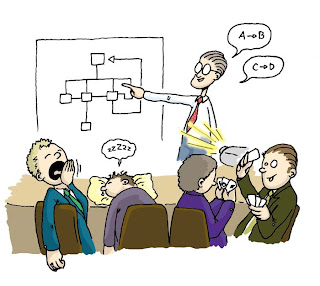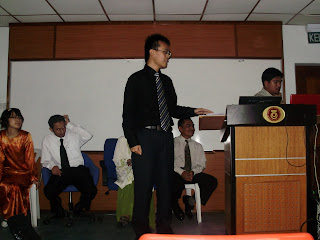
Resistance to Change - Why it Matters and What to Do About It
Nearly two-thirds of all major changes in organizations fail. That's pretty sobering information.
Did you know that:
* only about 30 percent of reengineering projects succeed
* 23 percent of mergers make back their costs
* 43 percent of quality improvement efforts are worth the effort
* 9 percent of major software applications are worth what you pay for them
Fortune 500 executives said that resistance was the primary reason changes failed. And 80 percent of the chief information officers said that resistance - not a lack of technical skills or resources - was the main reason why technology projects failed. It's that soft, touchy-feely, human reaction of resistance that matters.
But these statistics are only partly right. Resistance is not the primary reason why changes fail. The real problem is that leaders plan and roll out major changes in ways that create inertia, apathy, and opposition.
For example, an executive announces that the company will restructure starting next week. Employees and middle managers begin to resist. As the project unfolds, executives see resistance appear in many forms - malicious compliance, in-your-face arguments, even sabotage. The executives respond by pushing the change even harder. Then they make demands. Employees redouble their opposition and the change ends up either failing or going far over budget and way past deadlines.

Does this scenario sound at all familiar to you? If so, you're not alone. Here are some things to consider.
You've Got to Know What Creates Resistance to Change
Resistance is in the eye of the beholder. The people resisting don't see what they are doing as resistance - they often see it as survival.
Resistance to change is a reaction to the way a change is being led. There are no born "resistors" out there waiting to ruin otherwise perfect plans. People resist in response to something.
Resistance protects people from harm. If I'm a novice downhill skier, it's resistance that keeps me from taking the chair lift to the top of Bodycast Mountain. In an organization, resistance keeps me from saying "yes" to an assignment that I think will kill my career. After all, people aren't dopes.
The better we are at seeing what causes resistance, the easier it will be to build support for our ideas. In other words, if we understand resistance, we also understand the other side of that coin - support for change.
There are three levels of resistance.
Level 1 - I Don't Get It
Level 1 involves information: facts, figures, ideas. It is the world of thinking and rational action. It is the world of presentations, diagrams, and logical arguments.
Level 1 may come from . . .
* Lack of information
* Disagreement with data
* Lack of exposure to critical information
* Confusion over what it means
Many make the mistake of treating all resistance as if it were Level 1. Well-meaning leaders give people more information - hold more meetings, and make more PowerPoint presentations - when, in fact, something completely different is called for. And that's where Levels 2 and 3 come in.
Level 2 - I Don't Like It
Level 2 is an emotional reaction to the change. Blood pressure rises, adrenaline flows, pulse increases. It is based on fear: People are afraid that this change will cause them to lose face, status, control - maybe even their jobs.
Level 2 is not soft stuff. You can't say, "Just get over it," and expect people to say, "Wow, thanks, I needed that." Level 2 runs deep. When it kicks in, we can feel like our very survival is at stake.
When Level 2 is active, it makes communicating change very difficult. When adrenaline shoots through our system, we move into fight-or-flight mode (or we freeze, like a deer in the headlights). And we stop listening. So no matter how terrific your presentation is, once people hear "downsizing" their minds (and bodies) go elsewhere. And this is uncontrollable. They are not choosing to ignore you, it's just that they've got more important things on their minds - like their own survival.
Organizations usually don't encourage people to respond emotionally, so employees limit their questions and comments to Level 1 issues. They ask polite questions about budgets and timelines. So it may appear that they are with you, but they're not. They are asking Level 1 questions while hoping that you'll read between the lines and speak to their fears. And here is a really tricky part - they may not even be aware that they are operating on such a basic emotional level.
Level 3 - I Don't Like You
So maybe they like you, but they don't trust you - or don't have confidence in your leadership. That's a hard pill to swallow, I know. But lack of attention to Level 3 is a major reason why resistance flourishes and changes fail. And it is seldom talked about. Books on change talk about strategies and plans (all good stuff, to be sure) but most of this advice fails to recognize a major reason why change fails.
In Level 3 resistance, people are not resisting the idea - in fact, they may love the change you are presenting - they are resisting you. Maybe their history with you makes them wary. Perhaps they are afraid that this will be "a flavor of the month" like so many other changes, or that you won't have the courage to make the hard decisions to see this through.
But maybe its not you. People may resist those you represent. The statement, "Hi, I'm from headquarters, I'm here to help," often leaves people skeptical. If you happen to be that person from headquarters, you're going to have a hard time getting people to listen to you.
Whatever the reasons for this deeply entrenched resistance, you can't afford to ignore it.
People may understand the idea you are suggesting (Level 1), and they may even have a good feeling about the possibilities of this change (Level 2) - but they won't go along if they don't trust you.
How You Can Turn Resistance Into Support
Here are a few ideas to get you started addressing the various levels of resistance. And remember, all three levels could be in play simultaneously.
Level 1 - Make Your Case
* Make sure people know why a change is needed. Before you talk about how you want to do things, explain why something must be done.
* Present the change using language they understand. If your audience isn't made up of financial specialists, then detailed charts showing a lot of sophistical analysis of the numbers will be lost on them.
* Find multiple ways to make your case. People take in information in different ways. Some like to hear things. Others like to see things. Some like pictures. Others text. Some learn best in conversation. The more variety in the communication channels, the greater the chance that people will get what you have to say.
Level 2 - Remove as Much of the Fear as You Can - and Increase the Excitement about What's Positive About the Change
* Emphasize what's in it for them. People need to believe that the change will serve them in some way. For example, work will be easier, relationships will improve, career opportunities will open up, or job security will increase.
* Get them engaged in the process. People tend to support things they have a hand in building.
* Be honest. If a change will hurt them - downsizing, for instance - then tell the truth. It's the right thing to do, and it stops the rumor mill from inventing stories about what might happen. Also, honesty bolsters their trust in you (a Level 3 issue).
Level 3 - Rebuild Damaged Relationships - and Tend to Neglected Relationships
* Mea Culpa. Take responsibility for things that may have led to the current tense relations.
* Keep commitments. Demonstrate that you are trustworthy
* Find ways to spend time together so they get to know you (and your team). This is especially helpful if the resistance comes from "who you represent" and not just from your personal history together.
* Allow yourself to be influenced by the people who resist you. This doesn't mean that you give in to every demand, but that you can admit that you may have been wrong, and that they may ideas worth considering.
Article Source : http://www.beyondresistance.com/resistance_to_change.htm
































































